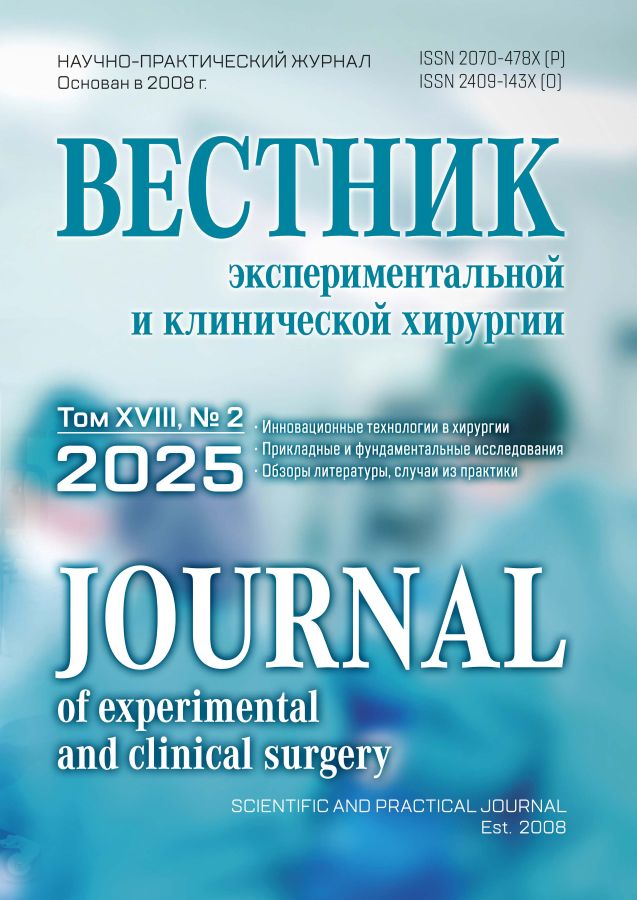Pancreatojejunostomy. Evolution of Thinking and Modern Trends
- Authors: Turchenko I.A.1, Shevchenko T.V.1, Stepanova Y.A.1, Ruzavin V.S.1, Popov A.Y.1, Gurmikov B.N.1
-
Affiliations:
- Vishnevsky National Medical Research Center of Surgery
- Issue: Vol 18, No 2 (2025)
- Pages: 105-115
- Section: Review of literature
- URL: https://vestnik-surgery.com/journal/article/view/1875
- DOI: https://doi.org/10.18499/2070-478X-2025-18-2-105-115
- ID: 1875
Cite item
Abstract
Pancreatojejunostomy is a key stage in performing pancreatoduodenal resection, as it is one of the major factors for developing postoperative pancreatic fistulas. The paper demonstrates the evolution of thinking in the global surgical community regarding interventions on the pancreas in general and pancreatodigestive anastomosis in particular. The attitude of pancreatologists to pancreato-digestive anastomosis has undergone radical changes since the end of the 19th century to the present day. For a long time, surgeons were restricted to perform only partial resections of the head of the pancreas, based on the postulates of its inviolability. However, the rapid development of medical technologies and surgical art throughout the 20th century led to the formation of an algorithm for pancreatoduodenal resection in its modern version, as well as the creation of numerous techniques for forming an anastomosis between the remnant of the pancreas and the small intestine. The article describes and illustrates the main modern technologies for forming a pancreatic anastomosis. Based on the data of the world literature, modern technologies for pancreatic anastomosis, their features, advantages and disadvantages are assessed. Additional options to prevent pancreatic fistulas during the pancreatojejunostomy are highlighted. Modern techniques for predicting complications during pancreatoduodenal resection are also described.
Full Text
About the authors
Ivan A. Turchenko
Vishnevsky National Medical Research Center of Surgery
Author for correspondence.
Email: iturchenko57@gmail.com
Postgraduate Student at the Oncology Department of Surgical Methods of Treatment
Russian Federation, MoscowTatiana V. Shevchenko
Vishnevsky National Medical Research Center of Surgery
Email: shev.tanechka@gmail.com
Ph.D., Surgeon at the Oncology Department of Surgery and Anticancer Drug Therapy
Russian Federation, MoscowYulia A. Stepanova
Vishnevsky National Medical Research Center of Surgery
Email: stepanovaua@mail.ru
M.D., Professor, Senior Researcher at the Department of Ultrasound
Russian Federation, MoscowVladimir S. Ruzavin
Vishnevsky National Medical Research Center of Surgery
Email: mfruzavin@yandex.ru
Ph.D., Surgeon at the Oncology Department of Surgical Methods of Treatment
Russian Federation, MoscowAnatoly Yu. Popov
Vishnevsky National Medical Research Center of Surgery
Email: popov_63@mail.ru
Ph.D., Head of the Department of Antitumor Drug Therapy
Russian Federation, MoscowBeslan N. Gurmikov
Vishnevsky National Medical Research Center of Surgery
Email: Gurmikov@mail.ru
M.D., Head of the Oncology Department of Surgical Methods of Treatment
Russian Federation, MoscowReferences
- Whipple AO, Parsons WB, Mullins CR. Treatment of carcinoma of the ampulla of vater. Ann Surg. 1935;102(4):763-79. doi: 10.1097/00000658-193510000-00023
- Karim SAM, Abdulla KS, Abdulkarim QH, Rahim FH. The outcomes and complications of pancreaticoduodenectomy (Whipple procedure): Cross sectional study. Int J Surg. 2018;52:383-387. doi: 10.1016/j.ijsu.2018.01.041
- Kaprin AD, Kostin AA, Nikiforov PV, Egorov VI, Grishin NA, Lozhkin MV, Petrov LO, Bykasov SA, Sidorov DV. Pancreatoduodenectomy: learning curve within single multi-field center. Hirurgiya. Zhurnal im. N.I. Pirogova. 2018; 4: 17-23. (in Russ.) doi: 10.17116/hirurgia2018417-23
- Enderes J, Pillny C, Standop J, Manekeller S, Kalff JC, Glowka TR. Operative Re-Intervention following Pancreatoduodenectomy: What Has Changed over the Last Decades. J Clin Med. 2022;11(24):7512. doi: 10.3390/jcm11247512
- Kovalenko ZA, Egorov VI, Petrov RV, Ananev DP, Fainstein IA, Dalgatov KD. Resectable periampullary tumor in patients with previous pancreatitis. What type of surgical procedure to choose? Hirurgiya. Zhurnal im. N.I. Pirogova. 2021; 6: 5-9. (in Russ.) doi: 10.17116/hirurgia20210615
- Gurmikov BN, Bolokov MS, Gurmikova NL. Long-term results of surgical treatment for pancreatic cancer. A review of literature. Kubanskij nauchnyj medicinskij vestnik. 2017; 1(2): 142-147. (in Russ.) doi: 10.25207/1608-6228-2017-2-142-147
- Kotelnikov AG, Patyutko YuI, Podluzhny DV, Saakyan MS, Kudashkin NE, Polyakov AN, Tikhonov PA, Suleimanov EA, Stilidi IS. Pancreatodigestive anastomosis: the key to a favorable outcome of pancreaticoduodenal resection. Annaly hirurgicheskoj gepatologii. 2022; 27(3): 92-99. (in Russ.) doi: 10.16931/1995-5464.2022-3-92-99
- Griffin JF, Wolfgang C. The history and evolution of pancreaticoduodenectomy. In Pancreatic Cancer: With Special Focus on Topical Issues and Surgical Techniques. Springer Berlin Heidelberg. 2017; 175-183. doi: 10.1007/978-3-662-47181-4_14
- Halsted WS Contributions to the Surgery of the Bile Passages, Especially of the Common Bile-Duct. The New England Journal of Medicine. 1899; 14(1): 645-654.
- Shalimov AA. Bolezni podzheludochnoj zhelezy i ih hirurgicheskoe lechenie. M.: Medicina. 1970; 280. (in Rus)
- Whipple AO. The rationale of radical surgery for cancer of the pancreas and ampullary region. Ann Surg. 1941; 114(4): 612-5. doi: 10.1097/00000658-194111440-00008
- Hunt VC. Surgical management of carcinoma of the ampulla of vater and of the periampullary portion of the duodenum. Ann Surg. 1941; 114(4): 570-602. doi: 10.1097/00000658-194110000-00006
- Griffin JF, Poruk KE, Wolfgang CL. Pancreatic cancer surgery: past, present, and future. Chin J Cancer Res. 2015;27(4):332-48. doi: 10.3978/j.issn.1000-9604.2015.06.07
- Child CG III Carcinoma of duodenum: one-stage radical pancreaticoduodenectomy preserving the external pancreatic secretion, case report. Ann Surg. 1941; 11(8): 838–842.
- Chang Wu B, Wlodarczyk J, Nourmohammadi Abadchi S, Shababi N, Cameron JL, Harmon JW. Revolutionary transformation lowering the mortality of pancreaticoduodenectomy: a historical review. Gastroenterology. 2023;1(2):e100014. doi: 10.1136/egastro-2023-100014
- Cattell RB. A technic for pancreatoduodenal resection. Surg Clin North Am. 1948;28:761-75. doi: 10.1016/s0039-6109(16)32452-5
- Lin PW, Lee JC, Lee PC, Chang TW, Hung CJ, Chang YC. A simple, secure and universal pancreaticojejunostomy following pancreaticoduodenectomy. HPB Surg. 1997;10(5):305-10. doi: 10.1155/1997/10729
- Van Roessel S, Mackay TM, Tol JAMG, van Delden OM, van Lienden KP, Nio CY, Phoa SSKS, Fockens P, van Hooft JE, Verheij J, Wilmink JW, van Gulik TM, Gouma DJ, Busch OR, Besselink MG. Impact of expanding indications on surgical and oncological outcome in 1434 consecutive pancreatoduodenectomies. HPB (Oxford). 2019; 21(7):865-875. doi: 10.1016/j.hpb.2018.10.020
- Merath K, Mehta R, Tsilimigras DI, Farooq A, Sahara K, Paredes AZ, Wu L, Ejaz A, Pawlik TM. In-hospital Mortality Following Pancreatoduodenectomy: a Comprehensive Analysis. J Gastrointest Surg. 2020;24(5):1119-1126. doi: 10.1007/s11605-019-04307-9
- Kawaida H, Kono H, Hosomura N, Amemiya H, Itakura J, Fujii H, Ichikawa D. Surgical techniques and postoperative management to prevent postoperative pancreatic fistula after pancreatic surgery. World J Gastroenterol. 2019;25(28):3722-3737. doi: 10.3748/wjg.v25.i28.3722
- Olakowski M, Grudzińska E, Mrowiec S. Pancreaticojejunostomy-a review of modern techniques. Langenbecks Arch Surg. 2020;405(1):13-22. doi: 10.1007/s00423-020-01855-6
- Cao Z, Luo W, Qiu J, Liu Y, Zheng L, Zhang T. Is Invagination Anastomosis More Effective in Reducing Clinically Relevant Pancreatic Fistula for Soft Pancreas After Pancreaticoduodenectomy Under Novel Fistula Criteria: A Systematic Review and Meta-Analysis. Front Oncol. 2020;10:1637. doi: 10.3389/fonc.2020.01637
- Xiang Y, Wu J, Lin C, Yang Y, Zhang D, Xie Y, Yao X, Zhang X. Pancreatic reconstruction techniques after pancreaticoduodenectomy: a review of the literature. Expert Rev Gastroenterol Hepatol. 2019;13(8):797-806. doi: 10.1080/17474124.2019.1640601
- Shevchenko TV, Gurmikov BN, Turchenko IA, Karmazanovsky GG, Stepanova YuA, Kovalenko YuA, Zhao AV, Kozlov IA, Ikramov RZ. The influence of the method of forming pancreaticodigestive anastomosis on the immediate results of pylorus-preserving pancreaticoduodenectomy. Klinicheskaya i eksperimental'naya hirurgiya. Zhurnal imeni akademika B.V. Petrovskogo. 2023; 11(3): 84-91. (in Russ.) doi: 10.33029/2308-1198-2023-11-3-84-91
- XY, Zhi XT. End-to-End Invaginated Pancreaticojejunostomy with Three Overlapping U-Sutures-A Safe and Simple Method of Pancreaticoenteric Anastomosis. J Invest Surg. 2015;28(2):115-9. doi: 10.3109/08941939.2014.982313
- Wang D, Liu X, Wu H, Liu K, Zhou X, Liu J, Guo W, Zhang Z. Clinical evaluation of modified invaginated pancreaticojejunostomy for pancreaticoduodenectomy. World J Surg Oncol. 2020;18(1):75. doi: 10.1186/s12957-020-01851-6
- Peng SY, Wang JW, Li JT, Mou YP, Liu YB, Cai XJ. Binding pancreaticojejunostomy--a safe and reliable anastomosis procedure. HPB (Oxford). 2004;6(3):154-60. doi: 10.1080/13651820410016598
- Shinde RS, Acharya R, Chaudhari VA, Bhandare MS, Shrikhande SV. Pancreaticojejunostomy for Pancreatico-enteric Anastomosis after Pancreaticoduodenectomy: one procedure with multiple techniques. Surgery in Practice and Science. 2020; 3: 100019. doi: 10.1016/j.sipas.2020.100019
- Hai H, Li Z, Zhang Z, Cheng Y, Liu Z, Gong J, Deng Y. Duct-to-mucosa versus other types of pancreaticojejunostomy for the prevention of postoperative pancreatic fistula following pancreaticoduodenectomy. Cochrane Database Syst Rev. 2022;3(3):CD013462. doi: 10.1002/14651858.CD013462.pub2
- Zhang B, Li L, Liu H, Li L, Wang H, Li Y, Wang Y, Sun B, Chen H. A modified single-needle continuous suture of duct-to-mucosa pancreaticojejunostomy in pancreaticoduodenectomy. Gland Surg. 2023;12(12):1642-1653. doi: 10.21037/gs-23-340
- Sun Y, Yu XF, Yao H, Xu S, Ma YQ, Chai C. Safety and feasibility of modified duct-to-mucosa pancreaticojejunostomy during pancreatoduodenectomy: A retrospective cohort study. World J Gastrointest Surg. 2023;15(9):1901-1909. doi: 10.4240/wjgs.v15.i9.1901
- Kakita A, Takahashi T, Yoshida M, Furuta K. A simpler and more reliable technique of pancreatojejunal anastomosis. Surg Today. 1996;26(7):532-5. doi: 10.1007/BF00311562
- Blumgart LH, Fong Y. Surgery of the Liver and Biliary Tract. 3rd edn. M.: Saunders Co Ltd., New York. 2000; 2180.
- Gupta V, Kumar S, Gupta V, Joshi P, Rahul R, Yadav RK, Dangi A, Chandra A. Blumgart's technique of pancreaticojejunostomy: Analysis of safety and outcomes. Hepatobiliary Pancreat Dis Int. 2019;18(2):181-187. doi: 10.1016/j.hbpd.2019.01.007
- Li Z, Wei A, Xia N, Zheng L, Yang D, Ye J, Xiong J, Hu W. Blumgart anastomosis reduces the incidence of pancreatic fistula after pancreaticoduodenectomy: a systematic review and meta-analysis. Sci Rep. 2020;10(1):17896. doi: 10.1038/s41598-020-74812-4
- Cao F, Tong X, Li A, Li J, Li F. Meta-analysis of modified Blumgart anastomosis and interrupted transpancreatic suture in pancreaticojejunostomy after pancreaticoduodenectomy. Asian J Surg. 2020;43(11):1056-1061. doi: 10.1016/j.asjsur.2020.01.011
- Ricci C, Ingaldi C, Alberici L, Pagano N, Mosconi C, Marasco G, Minni F, Casadei R. Blumgart Anastomosis After Pancreaticoduodenectomy. A Comprehensive Systematic Review, Meta-Analysis, and Meta-Regression. World J Surg. 2021;45(6):1929-1939. doi: 10.1007/s00268-021-06039-x
- PARANOIA Study Group; Writing committee; Pande R, Halle-Smith JM, Phelan L, Thorne T, Panikkar M, Hodson J, Roberts KJ; Steering committee; Arshad A, Connor S, Conlon KC, Dickson EJ, Giovinazzo F, Harrison E, de Liguori Carino N, Hore T, Knight SR, Loveday B, Magill L, Mirza D, Pandanaboyana S, Perry RJ, Pinkney T, Siriwardena AK, Satoi S, Skipworth J, Stättner S, Sutcliffe RP, Tingstedt B. External validation of postoperative pancreatic fistula prediction scores in pancreatoduodenectomy: a systematic review and meta-analysis. HPB (Oxford). 2022;24(3):287-298. doi: 10.1016/j.hpb.2021.10.006
- Yamamoto Y, Sakamoto Y, Nara S, Esaki M, Shimada K, Kosuge T. A preoperative predictive scoring system for postoperative pancreatic fistula after pancreaticoduodenectomy. World J Surg. 2011;35(12):2747-55. doi: 10.1007/s00268-011-1253-x
- Roberts KJ, Karkhanis S, Pitchaimuthu M, Khan MS, Hodson J, Zia Z, Mehrzad H, Marudanayagam R, Muiesan P, Isaac J, Mirza D, Sutcliffe RP. Comparison of preoperative CT-based imaging parameters to predict postoperative pancreatic fistula. Clin Radiol. 2016;71(10):986-992. doi: 10.1016/j.crad.2016.06.108
- Gagnière J, Abjean A, Franz M, Aumont O, Pereira B, Dupré A, Veziant J, Le Roy B, Boyer L, Pezet D, Buc E. A Normal Preoperative Lipase Serum Level Is an Easy and Objective Risk Factor of Pancreatic Fistula After Pancreaticoduodenectomy. Pancreas. 2017;46(9):1133-1140. doi: 10.1097/MPA.0000000000000905
- Callery MP, Pratt WB, Kent TS, Chaikof EL, Vollmer CM Jr. A prospectively validated clinical risk score accurately predicts pancreatic fistula after pancreatoduodenectomy. J Am Coll Surg. 2013 Jan;216(1):1-14. doi: 10.1016/j.jamcollsurg.2012.09.002
- Zhang W, Wei Z, Che X. Effect of polyglycolic acid mesh for prevention of pancreatic fistula after pancreatectomy: A systematic review and meta-analysis. Medicine (Baltimore). 2020;99(34):e21456. doi: 10.1097/MD.0000000000021456
- Deng Y, He S, Cheng Y, Cheng N, Gong J, Gong J, Zeng Z, Zhao L. Fibrin sealants for the prevention of postoperative pancreatic fistula following pancreatic surgery. Cochrane Database Syst Rev. 2020;3(3):CD009621. doi: 10.1002/14651858.CD009621.pub4
- Andreasi V, Partelli S, Crippa S, Balzano G, Tamburrino D, Muffatti F, Belfiori G, Cirocchi R, Falconi M. A systematic review and meta-analysis on the role of omental or falciform ligament wrapping during pancreaticoduodenectomy. HPB (Oxford). 2020;22(9):1227-1239. doi: 10.1016/j.hpb.2020.05.003
- Shrikhande SV, Sivasanker M, Vollmer CM, Friess H, Besselink MG, Fingerhut A, Yeo CJ, Fernandez-delCastillo C, Dervenis C, Halloran C, Gouma DJ, Radenkovic D, Asbun HJ, Neoptolemos JP, Izbicki JR, Lillemoe KD, Conlon KC, Fernandez-Cruz L, Montorsi M, Bockhorn M, Adham M, Charnley R, Carter R, Hackert T, Hartwig W, Miao Y, Sarr M, Bassi C, Büchler MW; International Study Group of Pancreatic Surgery (ISGPS). Pancreatic anastomosis after pancreatoduodenectomy: A position statement by the International Study Group of Pancreatic Surgery (ISGPS). Surgery. 2017;161(5):1221-1234. doi: 10.1016/j.surg.2016.11.021
- Jiang Y, Chen Q, Wang Z, Shao Y, Hu C, Ding Y, Shen Z, Jin M, Yan S. The Prognostic Value of External vs Internal Pancreatic Duct Stents in CR-POPF after Pancreaticoduodenectomy: A Systematic Review and Meta-analysis. J Invest Surg. 2021;34(7):738-746. doi: 10.1080/08941939.2019.1691687
- Guo C, Xie B, Guo D. Does pancreatic duct stent placement lead to decreased postoperative pancreatic fistula rates after pancreaticoduodenectomy? A meta-analysis. Int J Surg. 2022;103:106707. doi: 10.1016/j.ijsu.2022.106707
- Chen K, Liu Z, Yang B, Ma Y, Zhang S, Shao Z, Yang Y, Tian X. Efficacy and safety of early drain removal following pancreatic resections: a meta-analysis. HPB (Oxford). 2023;25(5):485-496. doi: 10.1016/j.hpb.2023.02.005
- Wu AGR, Mohan R, Fong KY, Chen Z, Bonney GK, Kow AWC, Ganpathi IS, Pang NQ. Early vs late drain removal after pancreatic resection-a systematic review and meta-analysis. Langenbecks Arch Surg. 2023;408(1):317. doi: 10.1007/s00423-023-03053-6
Supplementary files



















